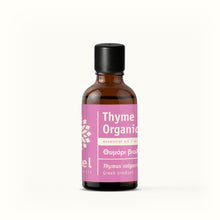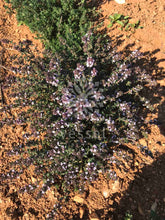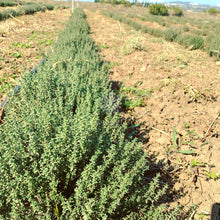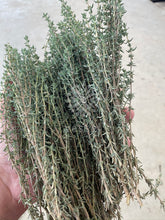Greek Thyme Organic Essential Oil
Regular price
€12.40
Sale
If you are interested in buying larger size quantities we would love to receive your email at info@vessel.gr
Greek Thyme Organic Essential Oil
Batch: E1001714



Other common names: common thyme, garden thyme, others
Botanical name: Thymus vulgaris
Chemotype: CT para-cymene/thymol/carvacrol
Botanical family: Lamiaceae (Labiatae)
Method of extraction: Steam distillation
Plant part used to extract the oil: flowering tops
Cultivation method: Organic
Area of origin: Greece
Historical notes:
Some historical records attribute the naming of the thyme plant to Theophrastus, 3rd century B.C. Greek philosopher and naturalist. Ancient Greeks believed thyme and its extracts could give them courage and restore vigour and mental alertness. They used sprigs of thyme in their baths and burned it as incense in their temples. It was an ingredient in ritual altar fires, to purify the sacrifices to the gods.
Biochemical group: Monoterpene
Main chemical compounds: para-cymene, thymol, γ-terpinene, carvacrol, linalool, β-caryophyllene, β-myrcene, α-thuyene, α-terpinene, 1,8-cineole, α-pinene, borneol, methyl carvacrol ether, camphene, terpinene-4-ol, limonene, methyl thymol ether, others
Colour: clear
Consistency: thin
Aroma strength: medium - strong
Perfumery note: middle
Aroma: herbaceous, terpenic, coniferous, with a hint of woody smokiness
Traditional aromatherapy uses:
- Traditionally in aromatherapy treatments thyme CT para-cymene essential oil is associated with the following therapeutic properties: analgesic, anti-microbial, anti-fungal and anti-viral, anti-rheumatic, expectorant, rubefacient
- Qualified aromatherapists may use thyme CT para-cymene essential oil for common complaints such as:
- skin conditions: cold sores and fungal infections
- respiratory conditions: respiratory infections, colds, coughs, bronchitis
- skeletomuscular problems: muscular aches and pains, arthritic and rheumatic pains
- How we use it:
Please, also see our How to Use Essential Oils Safely page for more information.
- For respiratory infections: inhale on its own or blended depending on the condition, we like it blended with some Lemon or Black Pine essential oils.
- For muscular aches and pains massage oil – we dilute our Thyme ct para-cymene with some Lemon essential oil in a fixed oil (carrier oil) and massage the affected areas (please remember that Lemon essential oil is phototoxic!). Another option is to blend it with some Rosemary and Lavandin essential oils.
Safety considerations:
Tisserand and Young do not include this specific thyme chemotype in their comprehensive Essential Oil Safety publication. [Robert Tisserand and Rodney Young, Essential Oil Safety (Second Edition. United Kingdom: Churchill Livingstone Elsevier, 2014), 452.]
Based on the thymol, carvacrol and para-cymene content we recommend max dermal use level at 1%. We also feel that caution should be exercised when using this oil as it might interacts with drugs, inhibit blood clotting, cause mucous and/or skin irritation. We do not recommend using this oil in a bath.
Please, also see our How to Use Essential Oils Safely page for more information.
Research and studies:
- Update on Monoterpenes as Antimicrobial Agents: A Particular Focus on p-Cymene
https://www.ncbi.nlm.nih.gov/pmc/articles/PMC5578313/
- Thyme Thymus vulgaris L. Thymol CT Essential Oil as Natural Preservative
http://www.essencejournal.com/pdf/2017/vol5issue2/PartA/5-1-23-185.pdf
- Thymus vulgaris essential oil: chemical composition and antimicrobial activity
https://www.ncbi.nlm.nih.gov/pmc/articles/PMC4391421/
Margaret Pawlaczyk-Karlinski MSc. (Hons.), Cert. Ed., M.I.F.A., NHS reg.















